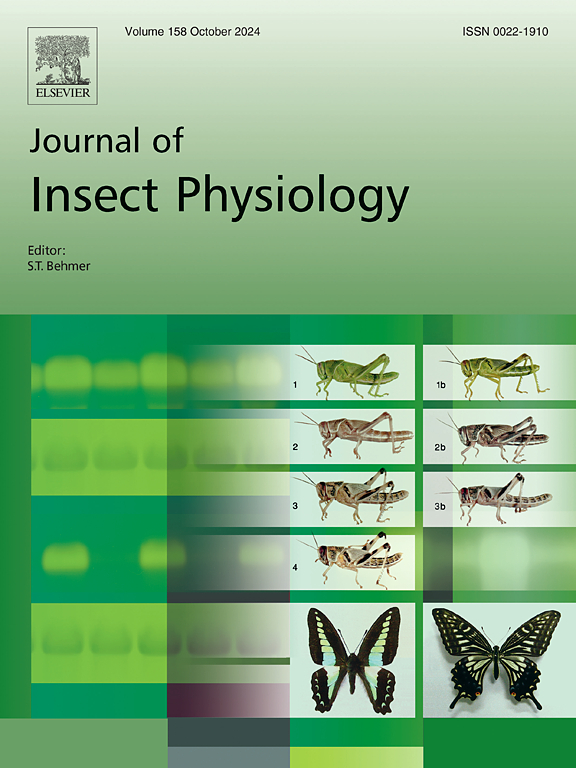Proline-rich nuclear receptor coactivator (Pnrc), the Drosophila aaquetzalli homologue, is important in survival of Henosepilachna vigintioctopunctata
IF 2.3
2区 农林科学
Q1 ENTOMOLOGY
引用次数: 0
Abstract
To develop a novel control strategy via a combination of double stranded RNA (dsRNA)-based pesticide and biocontrol in Henosepilachna vigintioctopunctata, we endeavored to identify potential dsRNAs that can cause living and non-feeding beetles to provide food for predators and parasitoids. In this context, depletion of proline-rich nuclear receptor coactivator (Pnrc), the Drosophila melanogaster aaquetzalli homologue, damages cuticle integrity. In the current paper, RNA interference (RNAi) targeting Hvpnrc by an injection of 200, 500 or 1000 ng of dspnrc into the third instar larvae significantly reduced the level of corresponding transcript and repressed pupation and adult eclosion, in a dose-dependent manner. The resultant female adults were malformed, with misshapen elytra and hindwings. They seldom moved, consumed less potato foliage, and hardly laid eggs. Most Hvpnrc RNAi beetles remained alive for more than a week before death. Silencing of Hvpnrc at the fourth larval instar or pupal stages caused more severe defective phenotypes. The Hvpnrc depleted adults seldom moved and did not consume potato foliage. They did not oviposit and eventually died within 10 days post eclosion. Taken together, dspnrc can cause delayed death and can exert an antifeeding effect; a dspnrc-based pesticide may be compatible with biocontrol when applied to the potato field to control H. vigintioctopunctata.

富脯氨酸核受体共激活因子(Pnrc)是aaquetzalli Drosophila aaquetzalli同源物,在Henosepilachna vigintioctopunctata的生存中起重要作用。
为了开发一种基于双链RNA (dsRNA)农药和生物防治相结合的新型防治策略,我们努力鉴定可能导致活的和非食性甲虫为捕食者和寄生蜂提供食物的dsRNA。在这种情况下,富含脯氨酸的核受体共激活因子(Pnrc),即黑腹果蝇的同系物的消耗,会损害表皮的完整性。在本文中,通过向三龄幼虫注射200,500或1000 ng的dspnrc靶向Hvpnrc的RNA干扰(RNAi),显著降低了相应的转录物水平,抑制了化蛹和成虫羽化,且呈剂量依赖性。由此产生的雌性成虫是畸形的,有畸形的鞘翅和后翅。它们很少移动,很少吃土豆叶,也几乎不产卵。大多数Hvpnrc RNAi甲虫在死亡前存活了一个多星期。在4龄或蛹期沉默Hvpnrc会导致更严重的表型缺陷。Hvpnrc枯竭的成虫很少移动,也不吃马铃薯叶。它们没有排卵,最终在10 天内死亡。综上所述,dspnrc可导致延迟死亡,并可发挥抗摄食作用;在马铃薯田施用含磷农药防治八爪蚜时,可与生物防治相适应。
本文章由计算机程序翻译,如有差异,请以英文原文为准。
求助全文
约1分钟内获得全文
求助全文
来源期刊

Journal of insect physiology
生物-昆虫学
CiteScore
4.50
自引率
4.50%
发文量
77
审稿时长
57 days
期刊介绍:
All aspects of insect physiology are published in this journal which will also accept papers on the physiology of other arthropods, if the referees consider the work to be of general interest. The coverage includes endocrinology (in relation to moulting, reproduction and metabolism), pheromones, neurobiology (cellular, integrative and developmental), physiological pharmacology, nutrition (food selection, digestion and absorption), homeostasis, excretion, reproduction and behaviour. Papers covering functional genomics and molecular approaches to physiological problems will also be included. Communications on structure and applied entomology can be published if the subject matter has an explicit bearing on the physiology of arthropods. Review articles and novel method papers are also welcomed.
 求助内容:
求助内容: 应助结果提醒方式:
应助结果提醒方式:


